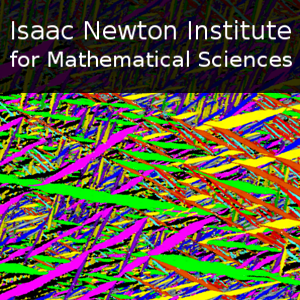Modeling and analysis of chromonic liquid crystal condensates
Duration: 45 mins 44 secs
Share this media item:
Embed this media item:
Embed this media item:
About this item

| Description: |
Calderer, C
Tuesday 14th May 2019 - 11:50 to 12:30 |
|---|
| Created: | 2019-05-15 16:06 |
|---|---|
| Collection: | The mathematical design of new materials |
| Publisher: | Isaac Newton Institute |
| Copyright: | Calderer, C |
| Language: | eng (English) |
| Distribution: |
World
|
| Explicit content: | No |
| Aspect Ratio: | 16:9 |
| Screencast: | No |
| Bumper: | UCS Default |
| Trailer: | UCS Default |
| Abstract: | The discovery of the liquid crystal phases of DNA and their study has attracted the attention of many scientists, for several decades. These include the contributions by soft matter physicists such as Professor F. Livolant, that began in the mid-1970’s. On the other hand, the observation of clustering phenomena in lyotropic liquid crystals, analogous to that formed by DNA condensates and bacteriophage viral genome in a capsid domain, led John Lyndon to coin the chromonic denomination of the liquid crystals formed by plank-like molecules (2013). All these liquid crystals are found to form hexagonal columnar chromonic phases, although they differ in order of magnitude by a factor of 106. This presentation addresses modeling and analysis of bacteriophage viruses, the toroidal structures formed by condensed DNA in free solutions, and the analogous phenomena observed in lyotropic chromonic liquid crystals phases of materials with plank-like molecular shapes. Part of the presentation will focus on the experiments performed by ProfessorLavrentovich’s group on materials such as food dyes--sunset yellow--and anti-asthmatic drugs. A special feature determining the arrangement of DNA in a capsid is the dominant contribution of the elastic energy penalizing distortion of the cross sections perpendicular to the column axis. The central mathematical problem is formulated as a free boundary problem for the Oseen-Frank and Ericksen’s energies, where the domain and the vector (or tensor) field are unknown. The admissible set includes volume constraints as well as those expressing the high resistance of the chromonic structures to splay and twist deformation. The first part of the presentation will involve general geometries of the domain, resorting to earlier analyses of liquid crystal droplets. We will subsequently show that minimizers of the bending dominated constrained energy have toroidal shapes. Moreover, we will show that axisymmetric configurations lead to families of polyconvex energies for which minimization can be established by standard methods of calculus of variations. Moreover, in the case of bacteriophage viruses, we will identify the absolute minimizer as the coiling DNA configuration. We will conclude the presentation with the discussion of a numerical algorithm aimed at the design of viruses for applications to drug delivery and nanotransport. |
|---|---|
Available Formats
| Format | Quality | Bitrate | Size | |||
|---|---|---|---|---|---|---|
| MPEG-4 Video | 640x360 | 1.94 Mbits/sec | 665.80 MB | View | Download | |
| WebM | 640x360 | 746.91 kbits/sec | 250.28 MB | View | Download | |
| iPod Video | 480x270 | 522.1 kbits/sec | 174.88 MB | View | Download | |
| MP3 | 44100 Hz | 249.75 kbits/sec | 83.75 MB | Listen | Download | |
| Auto * | (Allows browser to choose a format it supports) | |||||

